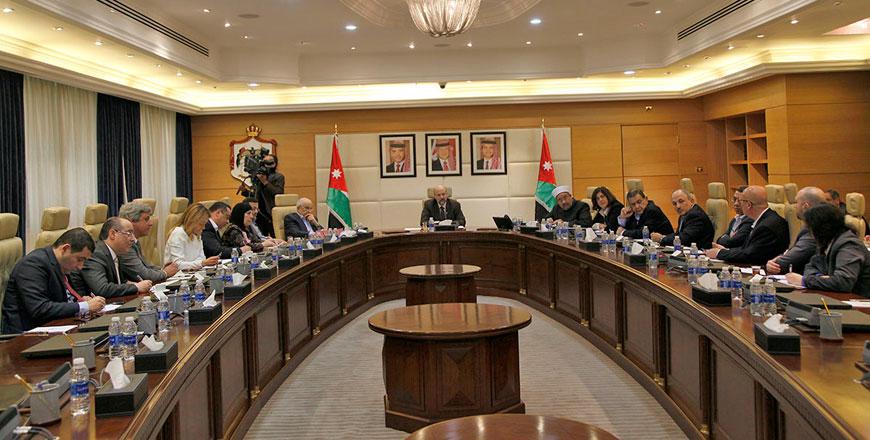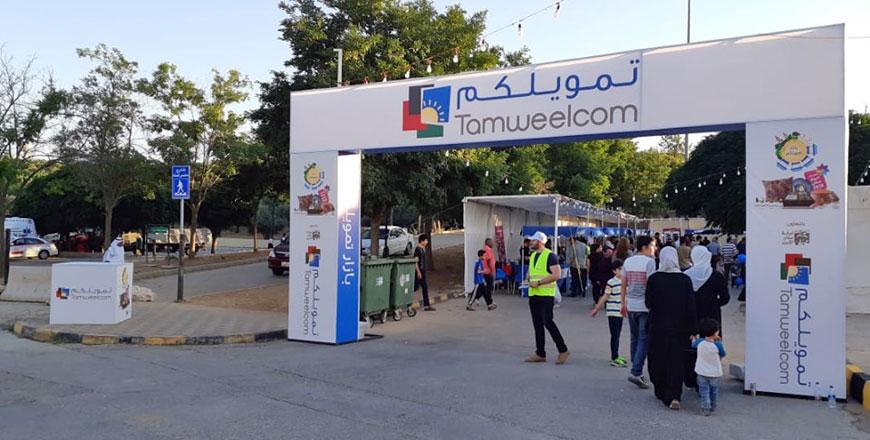You are here
The microfinance paradox: ‘lax’ regulations boost sector growth but predatory practices go unchecked
By Abdul Rahman Bazian - Feb 11,2019 - Last updated at Nov 05,2019
AMMAN — Microfinance loans comprised no more than 1 per cent of the country’s overall banking and finance sector’s credit facilities in 2017, approximately JD223 million, out of JD23.5 billion in total, according to the Central Bank of Jordan (CBJ).
Nonetheless, microfinance operations have provided tens of thousands of jobs and can potentially benefit millions of Jordanians in the years to come.
Total credit facilitated via microfinance institutions (MFIs) grew 10 per cent in just one year, from 2016’s JD200 million, CBJ data show.
Meanwhile, nearly 70 per cent of the sector’s issued credit is facilitated through branches in the governorates, outside of the capital, Amman, according to the CBJ.
As a mostly non-profit sector, the aim of microfinancing is to build economic capacity in local communities and further the implementation of the CBJ’s financial inclusion strategy, an international donor organisation that preferred to remain unnamed told The Jordan Times.
In recent years, the MFI industry began incorporating various financing models, to meet the needs of an unsatisfied market.
Since then, partnerships with international and local development agents allowed MFIs to reach beyond urban centres, to what the donor organisation described as “underserved locations”.
These locations are loosely defined as remote areas where residents have limited to no access to financial services and where people generally do not meet the minimum eligibility criteria to get loans from commercial banks.
Donors generally do not involve themselves in the details of MFI operations and structural issues, as they contend it is the CBJ’s responsibility.
However, despite remarkable growth rates, MFIs still face various challenges that negatively affect the overall outcome and benefit of the sector’s operations.
Regulatory shortcomings
Chief among these challenges are those resulting from shortcoming regulations, myopic planning and irresponsible practices by enterprises facilitating microloans informally, sector representatives claim.
According to the CBJ, there are nine licensed MFIs, all of whom are members of the Jordan Microfinance Network, Tanmeyah.
However, Executive Director of Tanmeyah Saleem Nammari warned there are dozens of enterprises operating outside the network.
They operate in the absence of CBJ oversight, as in “not licensed by the central bank”, he underlined.
In fact, there seems to have developed an unregulated, informal sector that lacks sufficient supervision, Nammari said.
“There are hundreds of them, preying on clients and borrowers with no regards to the consequences of their practices,” he claimed.
Notably, the central bank is supposed to be the sole financial authority supervising the sector. But there are companies registered under the Ministry of Industry, Trade and Supply operating without CBJ licences.
In July 2013, former chairman of the Tanmeyah Board of Directors Mustafa Nasser Al Din sent a formal communiqué to the Minister of Industry, citing copies sent to the governor of the central bank and the minister of Planning and International Cooperation, highlighting the dangers of such practices.
The document, a copy of which was obtained by The Jordan Times, underlines “unethical practices” of credit mediation enterprises, and lists a few of them.
According to Nammari, these enterprises are part of the problem, next to dozens of other companies facilitating loans and mediating for creditors and borrowers, illicitly.
When asked about it, the CBJ said that the 2015 Microfinance By-law No. (5) places the bank as the authority in charge of licensing, supervising and regulating MFIs.
“Companies engaged in microfinance operations were given two years to rectify their legal status and register with the central bank in accordance to the by-law,” the CBJ said.
In a phone interview with Maha Abdallat, head of the microfinance department at the CBJ, she said that companies — including credit mediation enterprises listed in the document that was provided for the CBJ’s review by The Jordan Times via e-mail — are not registered with the central bank and, therefore, the CBJ would not comment on the issue.
To inquire further on the issues, The Jordan Times contacted the Ministry of Industry.
According to ministry’s spokesperson,Yanal Barmawi, it is the CBJ’s job to monitor and supervise the operation and status of microfinance companies registered at the ministry.
“The ministry penalises companies operating outside of their registered scopes of business. If a company’s registration does not include in its scope the issuance of loans, micro or otherwise, but was found to have issued any such loans, the ministry intervenes and takes whatever correctional or penalising measure stipulated in the law. Otherwise, it is the CBJ’s job to monitor finance and mediation companies registered legally with the ministry,” Barmawi explained.
Meanwhile, the CBJ insisted that unlicensed financial institutions that are registered with the ministry are not on its radar.
Data on the exact number of ministry-registered unlicensed companies were not available.
While formal MFIs strive to facilitate “consumer-friendly” debt instruments for Jordanians, these enterprises operating informally pose a threat to the sector, Nammari contended.
They thrive in the unregulated segments of the market.
Predatory banking
Microfinance banking was established in 1976 in Bangladesh by Nobel Prize Laureate Muhammad Yunus, one of the founders of the Grameen Bank, the first institution to introduce Islamic tools and instruments of finance to the banking sector globally, proving to the world of finance that non-predatory banking does in fact work.
Yunus’ Grameen Bank was also amongst the first enterprises ever to utilise the concepts and mechanisms of microfinance in development.
Now, some 42 years later, the microfinance sector in Jordan has become one of the most important microcredit sources for Jordanians who do not meet the eligibility criteria for commercial bank loans.
Shafea Kayed, a former microfinance credit officer at a commercial bank, said: “These microcredit facilities are the lifeline of some small businesses and families, whose members are unemployed or whose salaries are below criteria,” and this is where it gets a little tricky.
The lack of centralised blanket supervision over the sector has enabled the rise of a predatory unregulated segment, sector officials say.
Violations by informal microfinance enterprises go unchecked, Nammari exclaimed, as there are no authorities to monitor them.
“They are ruining the sector’s reputation,” he said.
One of the most pressing public-opinion issues is locally known as the “gharimat” case, which refers to the imprisonment of indebted women who fail to make payments on their loans, many of whom claim to have received their microloans from women’s funds.
In an attempt to resolve the problem, the government — namely the Zakat Fund affiliated with the Ministry of Awqaf and Islamic Affairs — has been allocating finances to pay off the women’s debts.
Two weeks ago, the fund announced allocating some JD500,000 to make payments for indebted women, primarily those currently incarcerated, then those facing charges.
Ziad Rifai, vice chairman of Tanmeyah, former 12-year director of Tamweelcom and CEO of Ethmar, Jordan’s first Islamic microfinance enterprise, spoke extensively to The Jordan Times on the matter.
These issues are attributed in the media to MFIs, which is not true, Rifai and Nammari concurred.
Speaking on behalf of the network, Rifai said: “In 2018, the microfinance sector had more than 300,000 active clients across the Kingdom.”
In more than 20 years since the MFI sector was established, no more than 10,000 cases were filed against portfolio at risk (PAR) borrowers, Rifai stated.
PAR borrowers are clients whose non-performing loans have been so for more than 90 and sometimes 120 days, Rifai explained. “Out of all of them, only 100 were tried and sent to prison, in all those years, at the behest of the MFI network. None of them was a woman.”
Most of these cases were settled without sentences or jail time, before they actually went to court, Rifai explained. “We do not seek judicial intervention. Why would we? That would only kill the loan, rendering it unsalvageable. We would rather be patient with our borrowers and clients, because once they’re sent to prison, the debt is dead.”
“We are not the problem,” said Nammari.
Claiming to have communicated with correctional facilities’ administration, Nammari said that the total number of imprisoned women in Jordan is around 400 in total, for various charges, ranging from drug abuse to burglary, among others.
“We are waiting for an official document from the authorities, but we have not sent any women to jail. Not every women’s fund is ‘the women’s fund’. People have to validate the information they get. Many of those institutions that prey on people are operating illegally and are not members of the network of licensed MFIs. Not to mention credit mediation enterprises,” Nammari added.
According to Rifai, there is an inclination to look for more welfare-oriented practices within the sector, such as the 15 Islamic finance instruments increasingly used in microfinance today.
Ethmar, he said, is adopting zero-interest instalment tools to facilitate credit without interest and make profit via commission, as a business development agent for the merchant.
The risk-reward formula is fruitful, he added. “Not only for the zero-interest instalment method, but for all of the company’s tools.”
Driven by the aspiration to initiate a more “just” and consumer-friendly microfinance sector, Rifai said he looked to utilise instruments of finance consistent with Islam and the local culture, in order to build a more “sustainable” and balanced microcredit environment. For that purpose, Rifai said started Ethmar in 2015.
“It works,” he noted.
So far, PAR30 (inactive and unpaid loans for more than 30 days) and debts written off until the third quarter of 2018 do not comprise more than 1.8 per cent and 0.34 per cent of the network’s overall portfolio, respectively, Nammari confirmed.
The network’s figures show that the formal MFI sector has helped create more than 80,000 job opportunities through more than 1.3 million beneficiaries across the Kingdom.
Meanwhile, bad debt does not exceed 5 per cent, according to the figures Rifai shared with The Jordan Times. “If the financing sector applies all of the instruments of Islamic finance, we can then contribute to building a fairer financial economy.”
Predatory banking practices by the unregulated sector are counterproductive to the industry’s goals as a predominantly non-profit operation, Nammari reaffirmed.
For the industry as a whole, there is little regulation to keep the lending processes in check, unlike for commercial banks.
“The Central Bank of Jordan does not impose limits on bad debt ratios for MFIs, but based on best practice [benchmarks], there are standard acceptable, recommended limits for these ratios,” according to the CBJ.
During its regular on-site and off-site supervision duties, the CBJ monitors and assesses the quality of the loan portfolio of MFIs, and if the bad debt ratio exceeds these benchmark limits, the CBJ can take “any necessary action”.
According to Article No. (5/b) of the Instructions of Financial Consumer Protection for Microfinance Sector No. (15/2018), the credit policy of MFIs shall include in the minimum: (1) the maximum threshold of debt burden ratio for borrowers; (2) a clear mechanism for rescheduling non-performing loans; (3) a clear mechanism for group loans, whereby the obligations of all partners are clearly determined.
In light of that, and Article (9/a) of the aforementioned instructions, “MFIs should develop a clear and specified procedure to deal with defaulters and/or consumers with humanitarian conditions and emergency financial difficulties,” the CBJ underlined.
This helps keep the formal sector in check, but the absence of regulation to choke the informal sector allows for excessive interest rates and various predatory practices to go unchecked, economists argue.
When talking about banks and financial institutions, these enterprises operate under the central bank’s authority as an independent government body the primary and sole fiscal and financial authority, economist Mazen Marji said.
The point of microfinance is very different from that of banks, he noted, adding that “MFIs are driven by societal, developmental purposes”.
Unregulated institutions issuing microfinance loans, while operating partially legally, are merely loan sharks, driven entirely by profit, he warned.
“They are profiteering at the expense of people and MFIs alike. I remember attending the first microfinance conference in Jordan, back in the late 1990s. His Royal Highness Prince Hassan inaugurated the conference encompassing all of Jordan’s then-charity enterprises. The conference gave way to the conceptualisation of the hybrid sector, bringing about the birth of the non-profit in Jordan, particularly in the field of socioeconomic development. That day, I saw hundreds of loan sharks looking to double their earnings by exploiting the needs of the impoverished and disfranchised,” he said.
“Twenty years ago, Jordan received loans from the European Union to develop micro- and small businesses at very low interest rates, as well as grants, but corruption prevented the realisation of this objective,” Marji alleged.
Jordan still faces the same problem today, somewhat, with the unregulated sector at least, he said.
“There are too many enterprises operating in the sector, formally and informally, within the MFI network and beyond, that do not follow a unified point of reference or authority. Meanwhile, the government seems to be oblivious to how further taxation on MFI operations will hurt both the sector and the borrowers. All of this affects the added value of the sector,” Nammari highlighted.
On the other hand, there are challenges within the regulated sector itself, including policy and fiscal issues that sector representatives claim hinder MFI growth.
Sectoral challenges
The costs of borrowing and lending for MFIs remain high, Nammari argued, which is reflected in the sector’s average lending rates.
“Authorities should work on the development of sustainable sources of funding for MFIs, to enable optimal microfinance operations. The bank’s 9 per cent interest rate is our zero; our baseline. Not to mention taxation,” he added.
MFIs face various sectoral and policy challenges, and taxation does not help, financial economist, Al Ghad columnist and head of the economics department Yousef Damra told The Jordan Times.
Read more on the challenges and issues resulting from fiscal and taxation policies hindering the sector, in the next article on the microfinance paradox, in Wednesday’s edition.
Additional reporting by Johanne Kalsaas
The microfinance paradox: ‘lax’ regulations boost sector growth but predatory practices go unchecked
Related Articles
AMMAN — In accordance with His Majesty King Abdullah’s directives, Prime Minister Omar Razzaz chaired a meeting on Saturday attended by Depu
AMMAN — After its establishment in 1976, and well into its blossoming in the early 2000s, the Grameen Bank in Bangladesh proved to the
AMMAN — Tamweelcom, a microfinance institution (MFI), is the first in Jordan to receive the “Smart Campaign – Client Protection” certificati

















